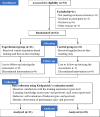A virtual simulation-based training program on birthing positions: a randomized controlled trial
- PMID: 37715171
- PMCID: PMC10503076
- DOI: 10.1186/s12912-023-01491-7
A virtual simulation-based training program on birthing positions: a randomized controlled trial
Abstract
Background: Restricting parturient women in healthcare facilities from choosing positions that provide the greatest comfort and benefit during labor is a global barrier. Several complex factors, including caregiver preference and medical intervention, shape the limitation. Therefore, a practical need exists to train midwives on the knowledge and skills to change this condition.
Methods: The study used a parallel, single-blind, randomized controlled trial at a provincial maternity and child health hospital in Fujian, China, from June 1 to December 31, 2019. The midwives in a birth suite were selected and randomly enrolled in a one-month simulation-based hybrid training or face-to-face teaching in September 2019. The four-level Kirkpatrick's model, including reaction, learning, behavior, and results, was used to evaluate training effects before and after the program. Data were analyzed with SPSS 25.0 using Student's t-test, Spearman's correlation test, Mann-Whitney U test, Wilcoxon signed-rank test, and chi-square test analysis of variance. The significance level was set at p < 0.05.
Results: Forty-two midwives were initially randomized to either the virtual simulation group or the face-to-face group. One midwife was excluded from the analysis due to intervention discontinuation, resulting in a final analysis of 41 midwives (n1 = 21, n2 = 20). Post-intervention, the virtual simulation group exhibited higher satisfaction and learning effects compared to the face-to-face group, while the rate of perineal incision in primiparas was lower (p<0.05). No significant changes or differences were observed in self-rated behavior between the two groups (p>0.05). The virtual simulation group demonstrated an increase in non-supine birth rate (p = 0.030) and a decrease in perineal incision rate among primiparas compared to pre-intervention (p = 0.035). Moreover, knowledge performance was associated with the duration of virtual simulation (r = 0.664, p = 0.001).
Conclusions: Virtual simulation is a fascinating innovation that enables midwives to develop birthing positions without practicing on real pregnant women and is one solution to achieve work competency within a shortened training period.
Keywords: In-service training; Kirkpatrick; Midwife; Position; Virtual simulation.
© 2023. BioMed Central Ltd., part of Springer Nature.
Conflict of interest statement
There are no conflicts of interest.
Figures


Similar articles
-
The effectiveness of internet-based e-learning on clinician behavior and patient outcomes: a systematic review protocol.JBI Database System Rev Implement Rep. 2015 Jan;13(1):52-64. doi: 10.11124/jbisrir-2015-1919. JBI Database System Rev Implement Rep. 2015. PMID: 26447007
-
Virtual reality simulation training for health professions trainees in gastrointestinal endoscopy.Cochrane Database Syst Rev. 2018 Aug 17;8(8):CD008237. doi: 10.1002/14651858.CD008237.pub3. Cochrane Database Syst Rev. 2018. PMID: 30117156 Free PMC article.
-
Evaluating the Instructional Design and Effect on Knowledge, Teamwork, and Skills of Technology-Enhanced Simulation-Based Training in Obstetrics in Uganda: Stepped-Wedge Cluster Randomized Trial.JMIR Med Educ. 2021 Feb 5;7(1):e17277. doi: 10.2196/17277. JMIR Med Educ. 2021. PMID: 33544086 Free PMC article.
-
Evaluation of a Mobile Telesimulation Unit to Train Rural and Remote Practitioners on High-Acuity Low-Occurrence Procedures: Pilot Randomized Controlled Trial.J Med Internet Res. 2019 Aug 6;21(8):e14587. doi: 10.2196/14587. J Med Internet Res. 2019. PMID: 31389340 Free PMC article. Clinical Trial.
-
Maternal position in the second stage of labour for women with epidural anaesthesia.Cochrane Database Syst Rev. 2018 Nov 9;11(11):CD008070. doi: 10.1002/14651858.CD008070.pub4. Cochrane Database Syst Rev. 2018. PMID: 30411804 Free PMC article.
References
-
- World Health Organization. WHO recommendations intrapartum care for a positive childbirth experience. https://www.who.int/publications/i/item/9789241550215. Accessed 28 February 2023. - PubMed
LinkOut - more resources
Full Text Sources

